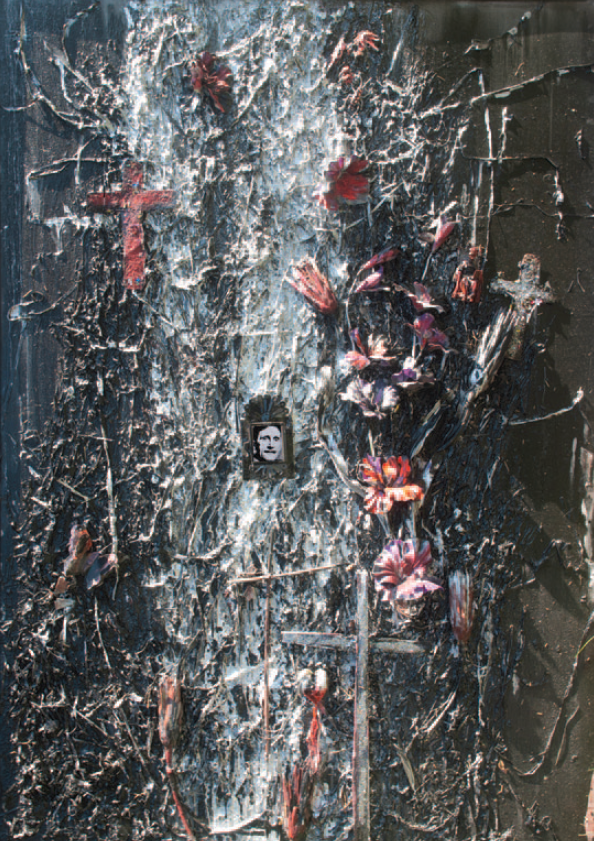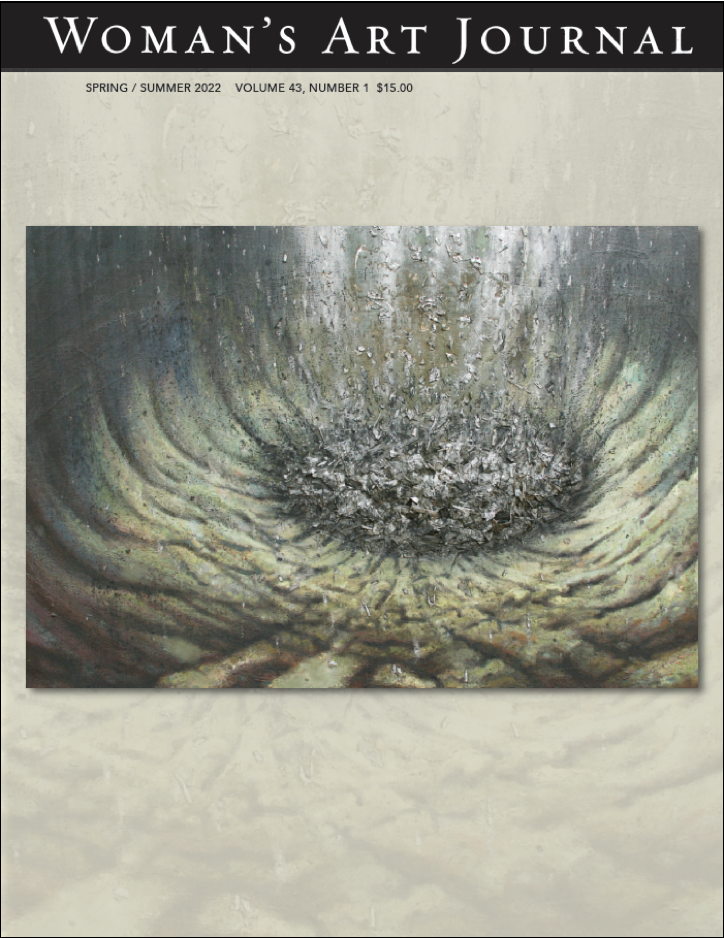The latest issue of Woman’s Art Journal, volume 43 issue 1 (Spring/Summer 2022), is now available.
Old City Publishing and our extended circle of staff members, board members, and contributors past and present offer profound thanks and wish the utmost happiness to Margaret Barlow, co-founder of Woman’s art Journal with Elsa Honig Fine, upon her retirement after forty-two years as innovator and copy editor. With her tireless dedication, high standards of scholarship, and calm, good-humored disposition, Peggy has enabled the journal to thrive in the difficult terrain of feminist art publications, a space where we have sustained our presence and position since 1980.
With Margaret retiring, we are very pleased to announce that Aliza Edelman, who joined the journal as book reviews editor in 2019 (upon the retirement of Ute Tellini), has become the co-editor of WAJ with Joan Marter. Aliza specializes in global feminisms and the transnational histories of abstraction in modern and contemporary art. Alison Poe, a specialist in the reception of Greek and Roman antiquity within a variety of gendered historical and pop-cultural contexts, is the new book reviews editor.




Contributing to the growing scholarly field on climate crisis and the Anthropocene, our first feature article treats Janet Culbertson’s forty-year commitment to ecological issues through her extraordinary corpus of paintings, drawings, and prints. “In today’s struggle to get justice for our natural environment,” author Margaret Bridget Betz asserts, “fighting those powers that turn our wilderness to a toxic wasteland can be a joyless effort, and while there are scenes of horror in Culbertson’s subjects, the painting surfaces often sparkle.”
The essay by Laura Elizabeth Shea offers a comprehensive study of Magnum photographer Inge Morath. Analyzing the photographer’s 1960 Road to Reno series through the dynamic act of positioning, Shea observes, “Morath’s photographs offer a new story for American mid-century and automobile travel, problematizing and making complex the experiences some Americans had on and off the road during the postwar years.” Shea notes a consistent obfuscation of clear viewpoints in these photographs, an uncertainty framing Morath’s penetrating vision of the American landscape that forces us, as viewers, to question how we look.
Shinoda Tōkō (who died in 2021 at age 107) forms the subjects of our contribution by emerging scholar Kimihiko Nakamura, who provides an extended biography and many important examples of the artist’s work and process. Shinoda was trained in East Asian calligraphy, the author explains, and yet her resulting abstract ink paintings disengage from lexical constraints and traditions in order to resist calligraphy’s “long-standing gendered division of styles”; likewise, they express a nuanced visual affinity with the bold black brushstrokes of mid-century Abstract Expressionism and Textual Abstraction. Shinoda exhibited with Betty Parsons Gallery and Bertha Schaefer Gallery in New York City in the 1950s.
Our articles travel backward through time to the early twentieth century. We conclude with Gwen John, a Welsh-born artist eminently deserving of attention for her paintings of the New Woman. Colleen Denney’s discerning essay on the artist’s self-portraiture argues for her performative agency and cultivated self-fashioning: “John’s embodiment of the professional woman artist … challenges the status quo for women at the turn of the twentieth century, and determines portraiture as a site of resistance for modern women’s identity formation.” John’s “confident stance” also brings new meaning to the concept of solitude for both the artist’s interior scenes and her individual choice of lifestyle.
Alison Poe has expertly shaped a suite of book reviews, many authored by new WaJ contributors. Two reviews make important contributions to the scholarship on Black women artists in America. Tiffany E. Barber masterfully considers a monograph on Loïs Mailou Jones, whose multifaceted aesthetic response to Blackness and womanhood is examined through the concept of “middleness—across different identities and locales, and within modernism itself.” Adrienne L. Childs probes an exhibition catalogue dedicated to Kara Walker’s personal archive of images that “lay bare the artist’s singular vision of the all-consuming dark gravitational forces of American racism.”
Analyzing an edited volume on feminist visual activism and the global body, Catherine Dormor applies the metaphor of dance and the ellipse to explore the authors’ dialogues “across time, space, bodies, and encounters as a form of choreography,” a schema that acts as a “collective activism.” Julia Skelly’s analysis of a new volume dedicated to transnational feminisms poses tactful questions about the author’s proposal to show how the arts, through coalition-building across feminist networks, “produce social change for marginalized and vulnerable individuals, including women of color, white women, and migrant women.” Christine Filippone draws upon a wide breadth of knowledge in science and art to tackle the interdisciplinary study reappraising the generative influences for contemporary artists of D’Arcy Wentworth Thompson’s on Growth and Form (1917, 2nd ed., 1942), foregrounding a processual view of evolution and anticipating more recent material feminisms.
Ellen Landau argues how the “new historical models” presented in a career-spanning exhibition catalogue on Joan Mitchell rightly claim the Abstract Expressionist painter’s greatness. Salomon Grimberg, an expert on Frida Kahlo, reviews three recent publications on the artist, including a new catalogue raisonné and the autobiography by Hayden Herrera, considered by this reviewer as the most welcome addition to the Kahlo literature. Two major retrospective catalogues are presented on artists whose body of work escapes strict categorization and the limitations of gender: Gabrielle Rose-Curti expounds the “staggering diversity and interdependency” of Sophie Taeuber-Arp’s abstractions; Barbara Stehle illuminates how Meret Oppenheim’s art goes beyond her iconic fur-covered object (1936). Reviewing a catalogue dedicated to Louise Bourgeois’s psychoanalytic writings, Nathalie Hager evaluates the perspectives on the artist and her work that arise from her “voyage to self-discovery.” Catherine Scallen appraises an interdisciplinary collection of essays on Mary of Hungary, the sixteenth-century art patron and leader whose innovative patronage and collecting in the visual arts and music, together with her “multiple identities” as Habsburg princess, queen, and long-governing regent warrant this greater attention in Anglophone scholarship.
We thank Old City Publishing for their continuing support of Woman’s art Journal through the many months when communications were difficult. Guy Griffiths and Ian Mellanby deftly managed the production of the issues for 2020 and 2021.
Joan Marter and Aliza Edelman
Editors, Woman’s Art Journal
Institutional subscribers can access issue by clicking here. The issue is available for purchase in print and digital (PDF) format. To subscribe to WAJ, click here.

p. 2
Parallel Perspectives
By Joan Marter and Aliza Edelman
p. 3-40
Portraits, Issues and Insights
p. 3
Icons In the Present Tense: Janet Culbertson’s Moral Imagination
By Margaret Bridget Betz
p. 12
“I Cannot Penetrate the Spirit”: Inge Morath’s Road to Reno (1960)
By Laura Elizabeth Shea
p. 21
Shinoda Tōkō: Ink, Abstraction, and Radical Individualism
By Kimihiko Nakamura
p. 31
“A View of The Open Sky”: Gwen John’s Early Modern Portraits and Interiors
By Colleen Denney
p. 41-68
Reviews
p. 41
D’Arcy Wentworth Thompson’s Generative Influences in Art, Design, and Architecture: From Forces to Forms Edited by Ellen K. Levy and Charissa N. Terranova
Reviewed by Christine Filippone
p. 45
Transnational Feminisms, Transversal Politics and Art: Entanglements and Intersections By Marsha Meskimmon
Reviewed by Julia Skelly
p. 47
Feminist Visual Activism and the Body Edited by Basia Sliwinska
Reviewed by Catherine Dormor
p. 50
Designing a New Tradition: Loïs Mailou Jones and the Aesthetics of Blackness By Rebecca VanDiver
Reviewed by Tiffany E. Barber
p. 52
Kara Walker: A Black Hole Is Everything a Star Longs to Be Edited by Anita Haldemann
Reviewed by Adrienne L. Childs
p. 54
Joan Mitchell Edited by Sarah Roberts and Katy Siegel
Reviewed by Ellen G. Landau
p. 56
Louise Bourgeois: Freud’s Daughter By Philip Larratt-Smith, with an essay by Juliet Mitchell
Reviewed by Nathalie Hager
p. 58
The Heart: Frida Kahlo in Paris By Marc Petitjean, trans. Adriana Hunter; Frida Kahlo: The Complete Paintings Edited by Luis-Martín Lozano; Upper Bohemia: A Memoir By Hayden Herrera
Reviewed by Salomon Grimberg
p. 61
Meret Oppenheim: My Exhibition Edited by Nina Zimmer, Natalie Dupêcher, and Anne Umland with Lee Colón and Nora Lohner
Reviewed by Barbara Stehle
p. 63
Sophie Taeuber-Arp: Living Abstraction Edited by Anne Umland and Walburga Krupp with Charlotte Healy
Reviewed by Gabrielle Rose-Curti
p. 66
Mary of Hungary, Renaissance Patron and Collector: Gender, Art, and Culture Edited by Noelia García Pérez
Reviewed by Catherine B. Scallen
Color Plates